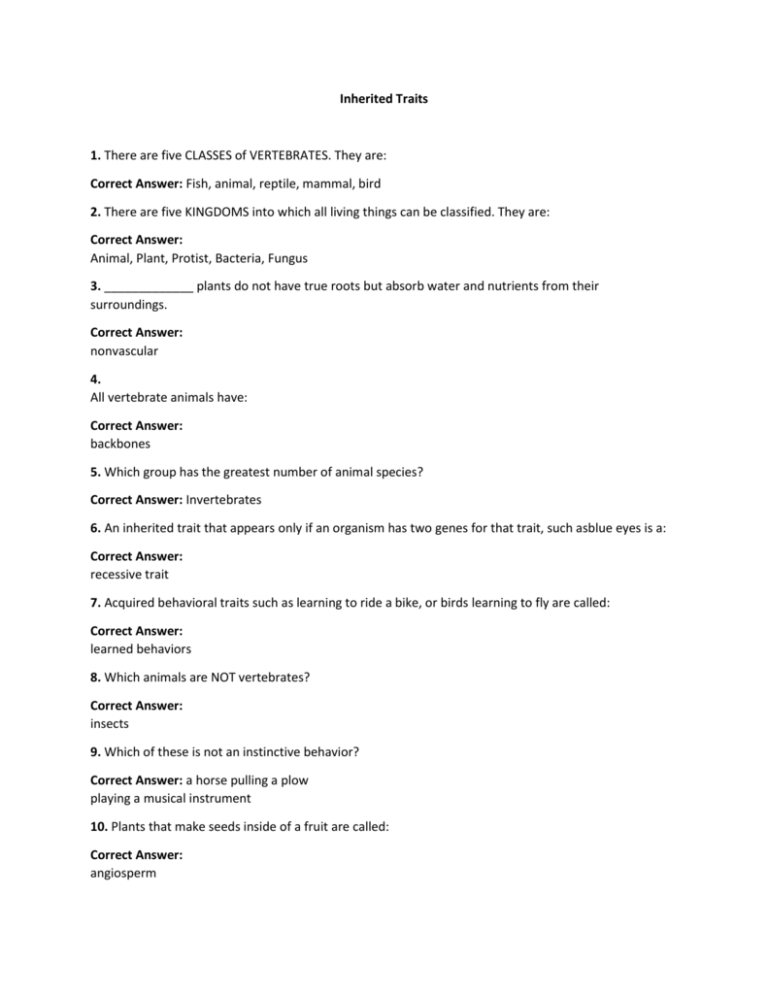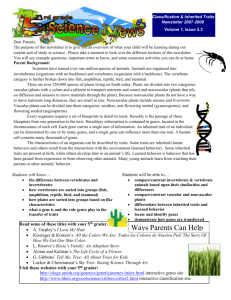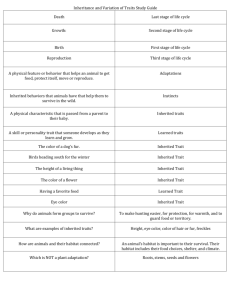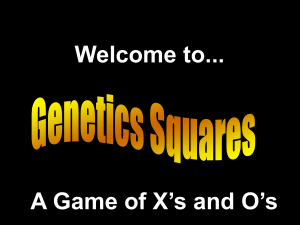Inherited Traits 1. There are five CLASSES of VERTEBRATES. They
advertisement

Inherited Traits 1. There are five CLASSES of VERTEBRATES. They are: Correct Answer: Fish, animal, reptile, mammal, bird 2. There are five KINGDOMS into which all living things can be classified. They are: Correct Answer: Animal, Plant, Protist, Bacteria, Fungus 3. _____________ plants do not have true roots but absorb water and nutrients from their surroundings. Correct Answer: nonvascular 4. All vertebrate animals have: Correct Answer: backbones 5. Which group has the greatest number of animal species? Correct Answer: Invertebrates 6. An inherited trait that appears only if an organism has two genes for that trait, such asblue eyes is a: Correct Answer: recessive trait 7. Acquired behavioral traits such as learning to ride a bike, or birds learning to fly are called: Correct Answer: learned behaviors 8. Which animals are NOT vertebrates? Correct Answer: insects 9. Which of these is not an instinctive behavior? Correct Answer: a horse pulling a plow playing a musical instrument 10. Plants that make seeds inside of a fruit are called: Correct Answer: angiosperm 11. Which of the following is most likely inherited by flowering plants? Correct Answer: the ability to produce seeds 12. Adam can roll his tongue. His younger brother Lee cannot. Which statement explains why? Correct Answer: Adam has a dominant factor for tongue-rolling. 13. Insects, arachnids, worms, and mollusks all belong to which group? Correct Answer: invertebrate 14. A frog moves to a nearby pond because its own pond is drying up. What changed for the frog to cause it to move? Correct Answer: its environment 15. Eye color, beak size, and color of hair are all examples of : Correct Answer: physical traits 16. All living things belong to one of six major groups called: Correct Answer: kingdoms 17. Blinking, breathing, dogs fetching, and birds following their mother are all : Correct Answer: behavioral traits 18. What does the word classify mean? Correct Answer: To group by using a set of rules 19. Fish, amphibians, reptiles, birds and mammals all belong to which group? Correct Answer: vertebrate 20. Inherited behavioral traits are called: Correct Answer: instincts 21. Which of these are characteristics of inherited traits? Correct Answer: having green eyes and brown hair 22. Organisms with a body covering of feathers are classified as: Correct Answer: birds 23. Traits are affected by how an organism interacts with : Correct Answer: it's environment 24. The largest group of invertebrates are: Correct Answer: arthropods 25. Smelts are fish that lay their eggs in the sand on beaches. When the eggs hatch, the babies know to go to the water. This is an example of: Correct Answer: instinct 26. After a kingdom, what is the next largest grouping of organisms? Correct Answer: phylum 27. Plants are classified by whether they are : Correct Answer: vascular/non-vascular 28. A person who breeds animals keeps careful records of the fur color of parents and offspring from each generations. The fur color is a trait transferred from generation to generation. What are the structures that carry the information for these traits? Correct Answer: the genes 29. Which class of vertebrate lays eggs, has teeth, and is cold-blooded? Correct Answer: reptile 30. Animals that usually have the same body temperature, regardless of their surroundings are called: Correct Answer: warm-blooded 31. Which is the best way to reasonably predict what a puppy will look like? Correct Answer: Look at both parents of the puppy. 32. Invertebrates with a hard outer shell called an exoskeleton are: Correct Answer: arthropod 33. Several scientists observe an animal with hair and wings. This animal is a: Correct Answer: bat 34. Plants that produce “naked” seeds are called: Correct Answer: gymnosperm 35. Scientists discovered an animal that has gills when it is young and lungs when it is mature. In which group will this animal most likely be classified? Correct Answer: amphibian 36. Which animals are cold-blooded, live part of their lives in water and part on land, and go through metamorphosis? Correct Answer: amphibians 37. The scientific name of a single type of living things includes the _________ and __________. Correct Answer: genus and species 38. The smallest group for classifying living things is: Correct Answer: species 39. Heredity, is the passing down of _______ traits from parents to offspring. Correct Answer: inherited 40. Which is a characteristic of reptiles? Correct Answer: they use lungs to breathe 41. Vertebrate animals that are distinguished by live birth, and the production of maternal milk are: Correct Answer: mammals 42. A dog learning to fetch and lay down, or a cat learning to come when you yell "HERE KITTY!" is developed over an organism's lifetime and called an: Correct Answer: acquired trait 43. An example of a mollusk is a: Correct Answer: snail 44. Which is a characteristic of vascular plants but NOT nonvascular plants? Correct Answer: can thrive in dry areas 45. Redwood trees can grow to be very tall. They can grow so tall because they are: Correct Answer: vascular 46. Which of the following describes a learned behavior in a dog? Correct Answer: guiding sheep 47. Which of these is a correct definition for a gene? Correct Answer: a hereditary unit consisting of a sequence of DNA 48. How is a fish different from a jellyfish? Correct Answer: A fish has a backbone.











